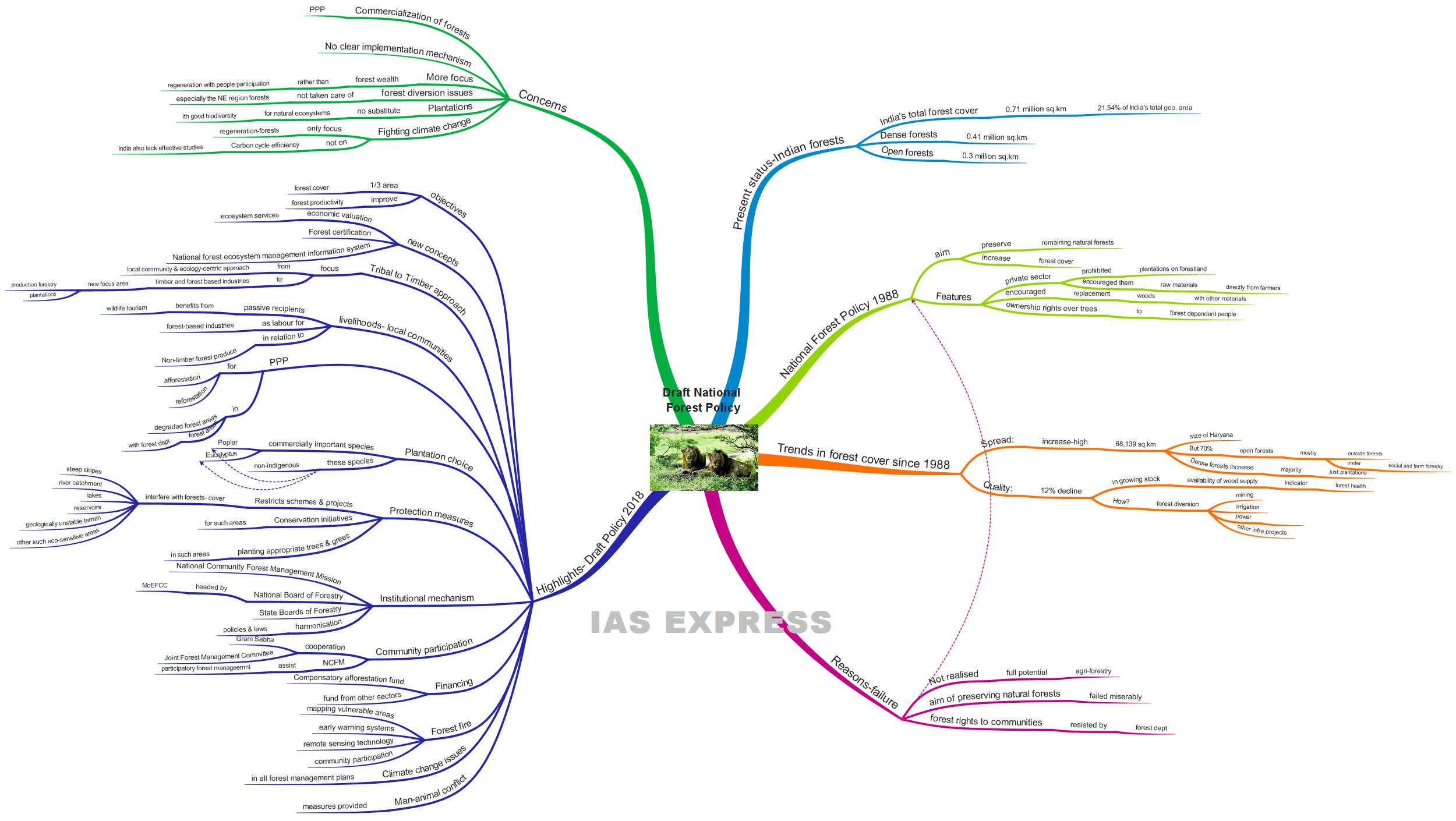Draft National Forest Policy 2018: Is it Pro-Industry?

From Current Affairs Notes for UPSC » Editorials & In-depths » This topic
IAS EXPRESS Vs UPSC Prelims 2024: 85+ questions reflected
The Parliamentary panel on environment and forests has raised serious concerns regarding the Draft National Forest Policy for its excessive focus on commercialization of forest and serving industry interests. Once finalized, this document will replace the current National Forest Policy, 1988.
What is the present situation of the forests in India?
- Forest Survey of India’s (FSI) The State of Forest Report (SFR) 2017 recorded India’s total forest cover as 0.71 million sq.km, which is 21.54% of the country’s geographical area.
- Out of this, dense forests (more than 40% canopy cover) are 0.41 million sq.km and open forests (10-40% canopy cover) is 0.3 million sq.km.
What is the National Forest Policy 1988?
- NFP 1988 aimed at preserving the remaining natural forests and for considerably increasing the forest cover in the country.
- It prohibited the private sector from growing plantation on forestland and promoted them to get raw materials directly from farmers.
- It encouraged the replacement of wood with other materials.
- It also entitled ownership rights over trees to the forest-dependent weaker sections for effective conservation efforts.
What are the trends in Forest cover since NFP-1988?
The spread of forest cover:
- India’s forest cover has been increased significantly by 68,139 sq.km in the past 30 years, which equals around 1.5 times the size of Haryana.
- However, most of the increase (70%) has been under the category of open forests, which are primarily degraded forests.
Quality:
- Growing Stock (availability of wood supply) is an indicator of forest health.
- But there has been a decline (12%) in growing stock for decades = indicates degradation.
- This could be due to the diversion of more than 10,000 sq.km forests for mining, irrigation, power, and other infrastructure projects.
Conclusion:
- The health of our forests has considerably declined.
- Majority of the increase in dense forests is just plantations on private land and changes in dense forest cover inside Recorded Forest Areas (Govt protected) are low.
- The increase is also attributed to the trees grown outside forests, mostly under social and farm forestry.
- Recorded forests have seen considerable degradation in the past 30 years, which has caused huge losses to ecological diversity in the country.
What are the reasons for the failure of NFP 1988?
- Increasing trees outside Recorded Forest Areas (RFAs) and promoting agroforestry is a welcome move, however, much needs to be done to realise the full utility of agro-forestry.
- The policy of replacing wood with plastic and metals have been successful, whereas, the aim of preserving the natural forests has failed miserably.
- Providing forest rights to forest-dependent communities is being resisted by the forest department.
- It has to be noted that, the Forest Rights Act 2006 took the matter out of the hands of the forest department, thereby facilitating community ownership of forestlands.
What are the highlights of the draft national forest policy?
Objectives:
- It aims at bringing a minimum of 1/3rd of India’s total geographical area under forest or tree cover.
- It seeks to resolve the concerns regarding the decline in forest productivity.
The draft has revealed some new concepts like:
- Economic valuation of ecosystem services.
- Forest certification.
- National forest ecosystem management information system.
Tribal to Timber Approach:
- NFP 1988 had a local community and ecology-centric approach.
- The draft policy shifts the focus to timber and forest-based industries.
- It identifies production forestry and plantations as the new thrust area for increasing the productivity of forest plantations + enabling forest industry interface.
- It aims to use degraded land available with forest corporations to produce quality timber in contrast to the focus on ‘fuelwood and forest development’ as in 1988 policy.
The draft mentions the livelihoods of local communities as:
- As passive recipients of benefits coming from wildlife tourism.
- As labour for forest-based industries.
- In relation to non-timber forest produce.
Public-Private Partnership (PPP):
- The draft introduces a PPP model for afforestation and reforestation activities.
- It will be implemented in degraded forest areas and forest areas available with Forest Development Corporations and outside forest areas.
Choice of Plantation:
- The draft suggests ‘commercially important species’ such as poplar and eucalyptus.
- Both of these species are non-indigenous species.
Protection Measures:
- It proposes to restrict schemes and projects which interfere with forests that cover steep slopes, the catchment of rivers, lakes, and reservoirs, geologically unstable terrain and such other ecologically sensitive areas.
- Such ecologically sensitive catchment areas will be stabilised with soil and water conservation initiatives.
- The draft also suggests planting appropriate trees and grass such as bamboo in these areas.
Institutional mechanism:
- It recommended establishing 2 national-level bodies for better management of the country’s forests.
- These are the National Community Forest Management (CFM) Mission and the National Board of Forestry (NBF). NBF will be headed by the union minister of environment, forests and climate change.
- The State Boards of Forestry (SBF) will have to facilitate inter-sectoral convergence, simplification of procedures, conflict resolution etc. SBF will have to be headed by state ministers in charge of forests.
- Measures should be taken for the harmonization between policies and laws such as the Forest Rights Act 2006.
Community participation:
- Measures for facilitating cooperation between gram sabha & JFMC (Joint Forest Management Committee) will be taken up = successful community participation in forest management.
- The CFM mission will assist in participatory forest management.
Financing:
- The Compensatory afforestation fund which is being provided to the states will be used for management of forests.
- It will be used for afforestation and rehabilitation works in degraded forest areas and for expanding forest and tree cover to new areas.
- Measures to source funds from other national sectors will also be taken. This may include tribal affairs, rural development, national highways, railways, coal, mines, power, etc.
Forest fire:
- The draft includes efforts to protect ecosystems from forest fires, which include:
- Mapping the vulnerable areas.
- Setting up and fostering early warning systems.
- Remote sensing technology to detect & control fire.
- Improve the participation of communities.
Climate change:
- Forests are natural carbon sinks helping in the mitigation of climate change.
- Therefore, climate change issues will be considered in all forest and wildlife areas working or management plans and community ecosystem management plans.
- Wildlife-rich areas and corridors outside protected zones would be identified and maintained for facilitating ecological and genetic continuity.
Man-animal conflict:
To address the issue of human-animal conflict, the draft proposes for
- quick response,
- dedicated teams of well-equipped and trained personnel,
- mobility,
- a strong interface with health and veterinary services,
- rescue centres,
- objective and speedy assessment of damage and
- quick payment of relief to the victims.
What are the concerns with the draft policy?
- Commercialisation of forests:
- Involving the private sector for afforestation and reforestation activities would mean privatisation of India’s natural resources and creating private forests.
- This would curtail the rights of tribals and forest-dwelling people on ownership and control of non-timber forest produce.
- No clear-cut implementation mechanism: It doesn’t provide for mechanisms for achieving the objectives considering the competitive demands for forestlands.
- Wrong focus: The draft focusses more on the conservation and preservation of forest wealth instead of regenerating them with people’s participation.
- Forest diversions:
- The policy does not discuss in detail the problem of diversion of forest land for mining and other purposes.
- Even though the draft mentions the importance of forests in the North-east region, it fails to resolve the forest diversion issues for projects in the region.
- Plantations are no substitute for natural ecosystems with good biodiversity. However, the policy gives too much attention on increasing the productivity of forest plantations and that too with exotic species such as eucalyptus and casuarina. Ecologists point out that improving ecosystems with indigenous species are key for ecological sustainability and for climate change mitigation.
- Fighting climate change:
- Mere regeneration of forests isn’t sufficient to check global warming.
- The efficiency of the Carbon cycle in forests (varies from forest to forest), is an important factor for climate change mitigation.
- However, India lacks effective studies to map forests and their potential for the carbon cycle. The draft policy doesn’t provide a roadmap to address these concern.
The above concerns need to be addressed while finalizing the new forest policy. The Parliament panel suggests that the Environment ministry must hold talks with tribal affairs ministry for protecting the rights of forest-dwellers. Apart from the tribal affairs ministry, the authorities must also discuss with local governments and civil society before finalizing the policy.
If you like this post, please share your feedback in the comments section below so that we will upload more posts like this.


